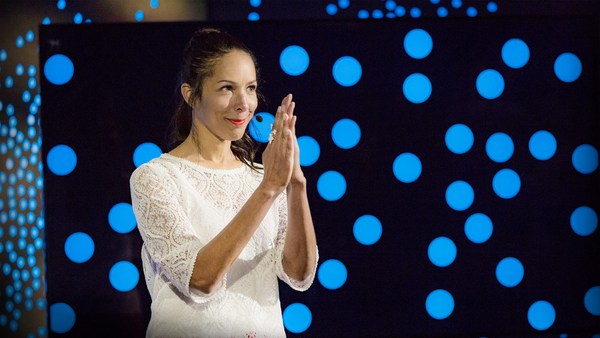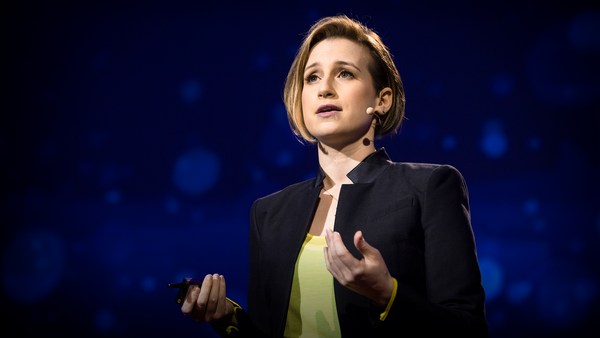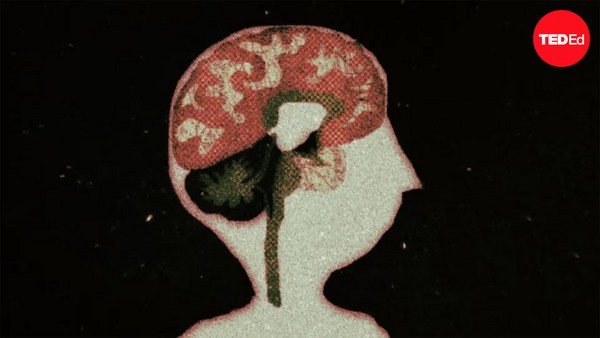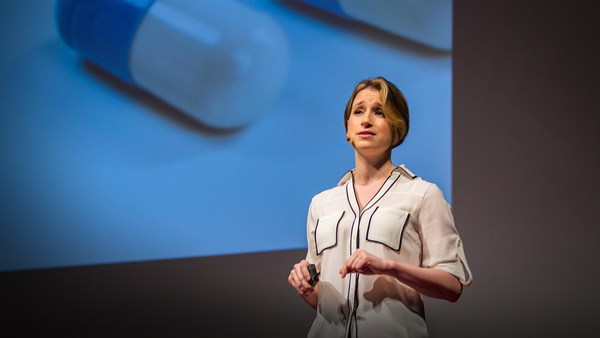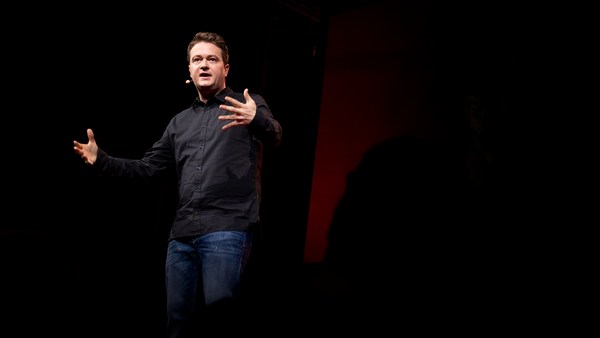Preparing for this talk has been scarier for me than preparing for LSD therapy.
(Laughter)
"Psychedelics are to the study of the mind what the microscope is to biology and the telescope is to astronomy." Dr. Stanislav Grof spoke those words. He's one of the leading psychedelic researchers in the world, and he's also been my mentor. Today, I'd like to share with you how psychedelics, when used wisely, have the potential to help heal us, help inspire us, and perhaps even to help save us.
In the 1950s and 60s, psychedelic research flourished all over the world and showed great promise for the fields of psychiatry, psychology and psychotherapy, neuroscience and the study of mystical experiences. But psychedelics leaked out of the research settings and began to be used by the counterculture, and by the anti-Vietnam War movement. And there was unwise use. And so there was a backlash. And in 1970, the US government criminalized all uses of psychedelics, and they began shutting down all psychedelic research. And this ban spread all over the world and lasted for decades. and it was tragic, since psychedelics are really just tools, and whether their outcomes are beneficial or harmful depends on how they're used.
Psychedelic means "mind-manifesting," and it relates to drugs like LSD, psilocybin, mescaline, iboga and other drugs. When I was 18 years old, I was a college freshman, I was experimenting with LSD and mescaline, and these experiences brought me in touch with my emotions. And they helped me have a spiritual connection that unfortunately, my bar mitzvah did not produce.
(Laughter)
When I wanted to tease my parents, I would tell them that they drove me to psychedelics because my bar mitzvah had failed to turn me into a man.
(Laughter)
But most importantly, psychedelics gave me this feeling of our shared humanity, of our unity with all life. And other people reported that same thing as well. And I felt that these experiences had the potential to help be an antidote to tribalism, to fundamentalism, to genocide and environmental destruction. And so I decided to focus my life on changing the laws and becoming a legal psychedelic psychotherapist.
(Applause)
Now, half a century after the ban, we're in the midst of a global renaissance of psychedelic research. Psychedelic psychotherapy is showing great promise for the treatment of post-traumatic stress disorder, or PTSD, depression, social anxiety, substance abuse and alcoholism and suicide. Psychedelic psychotherapy is an attempt to go after the root causes of the problems, with just relatively few administrations, as contrasted to most of the psychiatric drugs used today that are mostly just reducing symptoms and are meant to be taken on a daily basis.
Psychedelics are now also being used as tools for neuroscience to study brain function and to study the enduring mystery of human consciousness. And psychedelics and the mystical experiences they produce are being explored for their connections between meditation and mindfulness, including a paper just recently published about lifelong zen meditators taking psilocybin in the midst of a meditation retreat and showing long-term benefits and brain changes.
Now, how do these drugs work? Modern neuroscience research has demonstrated that psychedelics reduce activity in what's known as the brain's default mode network. This is where we create our sense of self. It's our equivalent to the ego, and it filters all incoming information according to our personal needs and priorities. When activity is reduced in the default mode network, our ego shifts from the foreground to the background, and we see that it's just part of a larger field of awareness. It's similar to the shift that Copernicus and Galileo were able to produce in humanity using the telescope to show that the earth was no longer the center of the universe, but was actually something that revolved around the sun, something bigger than itself. For some people, this shift in awareness is the most important and among the most important experiences of their lives. They feel more connected to the world bigger than themselves. They feel more altruistic, and they lose some of their fear of death.
Not all drugs work this way. MDMA, also known as Ecstasy, or Molly, works fundamentally different. And I'll be able to share with you the story of Marcela, who suffered from post-traumatic stress disorder from a violent sexual assault. Marcela and I were introduced in 1984, when MDMA was still legal, but it was beginning also to leak out of therapeutic circles. Marcela had tried MDMA in a recreational setting, and during that, her past trauma flooded her awareness and it intensified her suicidal feelings. During our first conversation, I shared that when MDMA is taken therapeutically, it can reduce the fear of difficult emotions, and she could help move forward past her trauma. I asked her to promise not to commit suicide if we were to work together. She agreed and made that promise.
During her therapeutic sessions, Marcela was able to process her trauma more fluidly, more easily. And yet, she was able to tell that the rapist had told her that if she ever shared her story, he would kill her. And she realized that that was keeping her a prisoner in her own mind. So being able to share the story and experience the feelings and the thoughts in her mind freed her, and she was able to decide that she wanted to move forward with her life. And in that moment, I realized that MDMA could be very effective for treating PTSD. Now, 35 years later, after Marcela's treatment, she's actually a therapist, training other therapists to help people overcome PTSD with MDMA.
Now, how does MDMA work? How did MDMA help Marcela? People who have PTSD have brains that are different from those of us who don't have PTSD. They have a hyperactive amygdala, where we process fear. They have reduced activity in the prefrontal cortex, where we think logically. And they have reduced activity in the hippocampus, where we store memories into long-term storage. MDMA changes the brain in the opposite way. MDMA reduces activity in the amygdala, increases activity in the prefrontal cortex and increases connectivity between the amygdala and the hippocampus to remit traumatic memories to move into long-term storage. Recently, researchers at Johns Hopkins published a paper in "Nature," in which they demonstrated that MDMA releases oxytocin, the hormone of love and nurturing. The same researchers also did studies in octopuses, who are normally asocial, unless it's mating season. But lo and behold, you give them MDMA, and they become prosocial.
(Laughter)
Several months after Marcela and I worked together, the Drug Enforcement Administration moved to criminalize Ecstasy, having no knowledge of its therapeutic use. So I went to Washington, and I went into the headquarters of the Drug Enforcement Administration, and I filed a lawsuit demanding a hearing, at which psychiatrists and psychotherapists would be able to present information about therapeutic use of MDMA to try to keep it legal. And in the middle of the hearing, the DEA freaked out, declared an emergency and criminalized all uses of MDMA. And so the only way that I could see to bring it back was through science, through medicine and through the FDA drug development process.
So in 1986, I started MAPS as a nonprofit psychedelic pharmaceutical company. It took us 30 years, till 2016, to develop the data that we needed to present to FDA to request permission to move into the large-scale Phase 3 studies that are required to prove safety and efficacy before you get approval for prescription use.
Tony was a veteran in one of our pilot studies. According to the Veterans Administration, there's over a million veterans now disabled with PTSD. And at least 20 veterans a day are committing suicide, many of them from PTSD. The treatment that Tony was to receive was three and a half months long. But during that period of time, he would only get MDMA on three occasions, separated by 12, 90-minute non-drug psychotherapy sessions, three before the first MDMA session for preparation and three after each MDMA session for integration. We call our treatment approach "inner-directed therapy," in that we support the patient to experience whatever's emerging within their minds or their bodies. Even with MDMA, this is hard work. And a lot of our subjects have said, "I don't know why they call this Ecstasy."
(Laughter)
During Tony's first MDMA session, he lay on the couch, he had eyeshades on, he listened to music, and he would speak to the therapists, who were a male-female co-therapy team, whenever he felt that he needed to. After several hours, in a moment of calmness and clarity, Tony shared that he had realized his PTSD was a way of connecting him to his friends. It was a way of honoring the memory of his friends who had died. But he was able to shift and see himself through the eyes of his dead friends. And he realized that they would not want him to suffer, to squander his life. They would want him to live more fully, which they were unable to do. And so he realized that there was a new way to honor their memory, which was to live as fully as possible. He also realized that he was telling himself a story that he was taking opiates for pain. But actually, he realized, he was taking them for escape. So he decided he didn't need the opiates anymore, he didn't need the MDMA anymore, and he was dropping out of the study. That was seven years ago. Tony is still free of PTSD, has never returned to opiates and is helping others less fortunate than himself in Cambodia.
(Applause)
The data that we presented to FDA from 107 people in our pilot studies, including Tony, showed that 23 percent of the people that received therapy without active MDMA no longer had PTSD at the end of treatment. This is really pretty good for this patient population. However, when you add MDMA, the results more than double, to 56 percent no longer having PTSD.
(Applause)
But most importantly, once people learn that if they don't need to suppress their trauma, but they can process it, they keep getting better on their own. So at the 12-month follow-up one year after the last treatment session, two-thirds no longer have PTSD. And of the one-third that do, many have clinically significant reductions in symptoms.
(Applause)
On the basis of this data, the FDA has declared MDMA-assisted psychotherapy for PTSD a breakthrough therapy. FDA has also declared psilocybin a breakthrough therapy for treatment-resistant depression and just recently approved esketamine for depression.
I'm proud to say that we have now initiated our Phase 3 studies. And if the results are as we hope, and if they're similar to the Phase 2 studies, by the end of 2021, FDA will approve MDMA-assisted psychotherapy for PTSD. If approved, the only therapists who will be able to directly administer it to patients are going to be therapists that have been through our training program, and they will only be able to administer MDMA under direct supervision in clinic settings. We anticipate that over the next several decades, there will be thousands of psychedelic clinics established, at which, therapists will be able to administer MDMA, psilocybin, ketamine and other psychedelics to potentially millions of patients. These clinics can also evolve into centers where people can come for psychedelic psychotherapy for personal growth, for couples therapy or for spiritual, mystical experiences.
Humanity now is in a race between catastrophe and consciousness. The psychedelic renaissance is here to help consciousness triumph. And now, if you all just look under your seats ... Just joking!
(Laughter)
Thank you.
(Applause)
(Laughter)
(Applause)
Thank you.
(Applause)
Corey Hajim: You've got to stay up here for a minute. Thank you so much, Rick. I guess it's a supportive audience.
Rick Doblin: Yes, very. Many of them have also been to Burning Man.
(Laughter)
CH: There's some synergy.
RD: (Laughs)
CH: So, in your talk, you talked about using these drugs to address some pretty serious traumas. So what about some more common mental illnesses like anxiety and depression, and is that where microdosing comes in?
RD: Well, microdosing can be helpful for depression, I do know someone that has been using it. But in general, for therapeutic purposes, we prefer macro-dosing rather than microdosing, in order to really help people deal with the root causes. Microdosing is more for creativity, for artistic inspiration, for focus ... And it also does have a mood-elevation lift. But I think for serious illnesses, we'd rather not get people thinking that they need a daily drug, but do more deeper, intense work.
CH: And what about outside the United States and North America, is this research being done there?
RD: Oh yeah, we're globalizing. Our Phase 3 studies are actually being done in Israel, Canada and the United States. So once we get approval in FDA, it will also become approved in Israel and in Canada. We're just starting research in Europe. And we're actually going to be training some therapists from China.
CH: That's great. We were going to do an audience vote to see if people felt like this was a good idea to move forward with this research or not, but I have a feeling I know the answer to that, so ... Thank you so much, Rick.
RD: Thank you. Thank you all.
(Applause)
